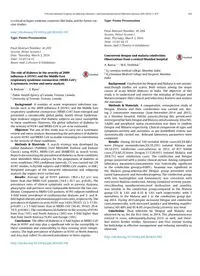
2016 The role of diabetes in the severity of 2009 influenza A (H1N1) and the Middle East respiratory syndrome coronaviru PDF
Preview 2016 The role of diabetes in the severity of 2009 influenza A (H1N1) and the Middle East respiratory syndrome coronaviru
17th International Congress on Infectious Diseases / International Journal of Infectious Diseases 45S (2016) 1–477 165 is critical in hyper-endemic countries like India, and for future vac- cine studies. http://dx.doi.org/10.1016/j.ijid.2016.02.391 Type: Poster Presentation Final Abstract Number: 41.203 Session: Poster Session I Date: Thursday, March 3, 2016 Time: 12:45-14:15 Room: Hall 3 (Posters & Exhibition) The role of diabetes in the severity of 2009 influenza A (H1N1) and the Middle East respiratory syndrome coronavirus (MERS-CoV): A systematic review and meta-analysis A. Badawi 1,∗, S. Ryoo 2 1 Public Health Agency of Canada, Toronto, Canada 2 University of Toronto, Toronto, Canada Background: A number of acute respiratory infections out- breaks such as the 2009 influenza A (H1N1) and the Middle East respiratory syndrome coronavirus (MERS-CoV) have emerged and presented a considerable global public health threat. Epidemio- logic evidence suggest that diabetic subjects are more susceptible to these conditions. However, the global influence of diabetes to the severity of H1N1 and MERS-CoV is yet to be evaluated. Objective: The aim of this study was to carry out a systematic review and meta-analysis documenting the prevalence of diabetes in sever H1N1 and MERS-CoV to enable estimating its contribution to the severity of these conditions. Methods & Materials: A search strategy was developed for online databases (PubMed, Ovid MEDLINE, Embase and Embase Classic) using H1N1, MERS-CoV and DIABETES as search terms. Reports documenting the prevalence of diabetes in these conditions were identified. Meta-analysis for the proportions of diabetes in sever conditions (95% confidence intervals, CI) was carried out (29 H1N1 studies, n=92,948 subjects and 9 MERS-CoV studies, n=308). Weighted averages of the extracted information and subgroup analysis (by region) were carried out. Results: Average age of H1N1 patients (38.0 ± 9.2 yrs) was lower than that MERS-CoV patients (54.9 ± 10.1 yrs, p<0.05). The prevalence rates of clinical symptoms such as pyrexia, dyspnea, pharyngitis and pertussis were comparable between the two con- ditions. Compared to MERS-CoV patients, H1N1 subjects exhibited 3-fold lower prevalence of cardiovascular diseases and 2- and 4- fold higher obesity and immunosuppression rates, respectively. The prevalence of diabetes in sever H1N1 was 14.6% (95%CI: 12.3-17.0%; p<0.001), a 3.7-fold lower than in MERS-CoV (54.4%; 95%CI: 29.4- 79.5; p<0.001). The contribution of diabetes to the severity of H1N1 from Asia (18%) and North America (20%) was 2-fold higher than that from South America (9.8%) and Europe (10%). Conclusion: The effect of diabetes is 4-fold higher in MERS-CoV than in H1N1 and may play a significant role in the susceptibly to these conditions and vulnerability to their ensuing sever compli- cations. The high prevalence of diabetes in H1N1 in North America and Asia may reflect its elevated prevalence in these regions. http://dx.doi.org/10.1016/j.ijid.2016.02.392 Type: Poster Presentation Final Abstract Number: 41.204 Session: Poster Session I Date: Thursday, March 3, 2016 Time: 12:45-14:15 Room: Hall 3 (Posters & Exhibition) Concurrent dengue and malaria coinfection: Observations from a central Mumbai hospital A. Barua 1,∗, M.E. Yeolekar 2 1 k.j somaiya medical college, Mumbai, India 2 K.J.Somaiya Medical College and Hospital, Mumbai, India Background: Coinfection by Dengue and Malaria is not uncom- mon,though studies are scarce. Both remain among the major causes of acute febrile illnesses in India. The objective of this study is to understand and observe the interplay of Dengue and Malaria,compare their clinical and laboratory features and analyze the outcomes. Methods & Materials: A comparative, retrospective study of Dengue, Malaria and their coinfections was carried out, dur- ing 2 consecutive monsoons (June-November;2014 and 2015), in a Mumbai hospital. Febrile patients,during this period,were investigated for both Dengue and Malaria simultaneously. Elisa(NS- 1/IgM) and peripheral smear examination was done to confirm Dengue and Malaria respectively. Clinical comparison of signs and symptoms,severity and outcomes, as per predefined criteria was systematically carried out.. Relevant laboratory parameters were compared. Results: During 2014,of 156 included febrile cases,85(54.48%) were Dengue monoinfection,55(35.25%) isolated Malaria and 16(10.25%) coinfection cases,whereas in 2015, of 417 febrile cases,272(65.2%)were Dengue,117(28.05%) isolated Malaria and 28(6.7%) were coinfection cases. The coinfection and Dengue groups presented with a similar clinical picture. Among compared laboratory parameters,transaminitis was statistically significant in the coinfection group(p<0.001). Anaemia was significant in the Malaria group,whereas,the Dengue group presented with raised haematocrit and thrombocytopenia. The coinfection group, with low haemoglobin and haematocrit, was consistent with concurrent Malaria coinfection. Among compared severity param- eters,bleeding manifestations,renal dysfunction and jaundice, was notable in the coinfection group,compared to the Malaria group(12% & 3.6% and 6.3% & 3.6% each respectively) with 3 mortalities in the Malaria and 1 in the coinfection group dur- ing 2014. During 2015,despite increased Dengue and coinfection cases,numerically, with increased jaundice and bleeding manifes- tations(16% &8% and 8% & 6% respectively),recovery was total. Conclusion: Dual infection by Dengue and Malaria was observed by us, for the first time, in 2014. This phenomenon,was noticed to recur, subsequently,during 2015. as well; and there- fore merits further studies. Awareness and thus routine testing for both,helps in effective management and reducing mortality as observed. http://dx.doi.org/10.1016/j.ijid.2016.02.393
